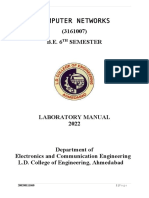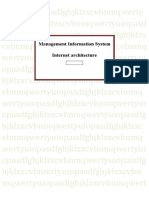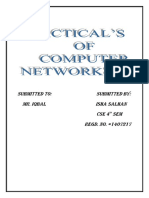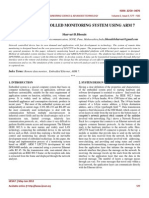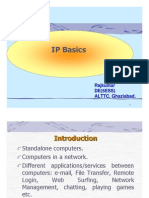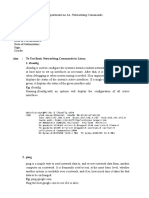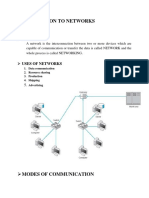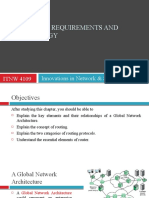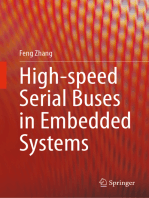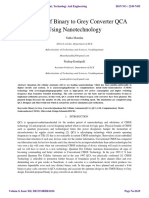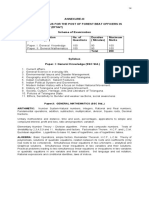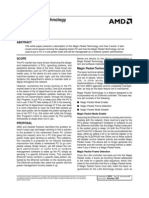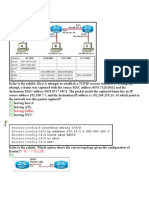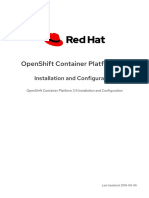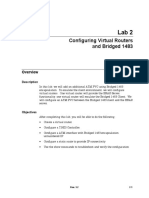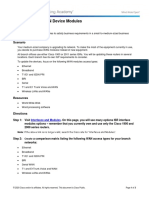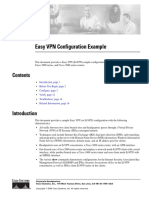20.verification of Four Port Router For Network On Chip (Noc)
20.verification of Four Port Router For Network On Chip (Noc)
Uploaded by
vijaykannamallaCopyright:
Available Formats
20.verification of Four Port Router For Network On Chip (Noc)
20.verification of Four Port Router For Network On Chip (Noc)
Uploaded by
vijaykannamallaOriginal Title
Copyright
Available Formats
Share this document
Did you find this document useful?
Is this content inappropriate?
Copyright:
Available Formats
20.verification of Four Port Router For Network On Chip (Noc)
20.verification of Four Port Router For Network On Chip (Noc)
Uploaded by
vijaykannamallaCopyright:
Available Formats
VERIFICATION OF FOUR PORT ROUTER FOR NETWORK ON CHIP
Michael K. Papamichael Computer Science Department Carnegie Mellon University Pittsburgh, PA, USA Email: papamix@cs.cmu.edu
Abstract: The focus of this Paper is the
actual implementation of Network Router and verifies the functionality of the four port router for network on chip using the latest verification methodologies, Hardware Verification Languages and EDA tools and qualify the IP for Synthesis an implementation. This Router design contains three output ports and one input port, it is packet based Protocol. This Design consists Registers and FIFO. For larger networks, where a direct-mapped approach is not feasible due to FPGA resource limitations, a virtualized timemultiplexed approach was used. Compared to the provided software reference implementation, our direct-mapped approach achieves three orders of magnitude speedup, while our virtualized time multiplexed approach achieves one to two orders of magnitude speedup, depending on the network and router configuration Keywords--Network-on-Chip ,Simulation Router,FIFO,FSM,Register blocks I INTRODUCTION 90% of ASIC respins are due to functional bugs. As the functional verification decides the quality of the silicon, we spend 60% of the design cycle time only for the verification/simulation. In order to avoid the delay and meet the TTM, we use the latest
978-1-4577-0118-4/11/$26.00 2011 IEEE
verification methodologies and technologies and accelerate the verification process. This project helps one to understand the complete functional verification process of complex ASICs an SoCs and it gives opportunity to try the latest verification methodologies, programming concepts like Object Oriented Programming of Hardware Verification Languages and sophisticated EDA tools, for the high quality verification. Why Would I Need a Router? For most home users, they may want to set-up a LAN (local Area Network) or WLAN (wireless LAN) and connect all computers to the Internet without having to pay a full broadband subscription service to their ISP for each computer on the network. In many instances, an ISP will allow you to use a router and connect multiple computers to a single Internet connection and pay a nominal fee for each additional computer sharing the connection. This is when home users will want to look at smaller routers, often called broadband routers that enable two or more computers to share an Internet connection. Within a business or organization,you may need to connect multiple computers to the Internet, but also want to connect multiple private networks Not all routers are created equal since their job will differ slightly from network to network.
Additionally, you may look at a piece of hardware and not even realize it is a router. What defines a router is not its shape, color, size or manufacturer, but its job function of routing data packets between computers. A cable modem which routes data between your PC and your ISP can be considered a router. In its most basic form, a router could simply be one of two computers running the Windows 98 (or higher) operating system connected together using ICS (Internet Connection Sharing). In this scenario, the computer that is connected to the Internet is acting as the router for the second computer to obtain its Internet connection. Going a step up from ICS, we have a category of hardware routers that are used to perform the same basic task as ICS, albeit with more features and functions. Often called broadband or Internet connection sharing routers, these routers allow you to share one Internet connection ple computers. Broadband or ICS routers will look a bit different depending on the manufacturer or brand, but wired routers are generally a small box-shaped hardware device with ports on the front or back into which you plug each computer, along with a port to plug in your broadband modem. These connection ports allow the router to do its job of routing the data packets between each of the computers and the data going to and from the Internet. Depending on the type of modem and Internet connection you have, you could also choose a router with phone or fax machine ports. A wired Ethernet broadband router will typically have a built-in Ethernet switch to allow for expansion. These routers also support NAT (network address translation), which allows all of your computers to share a single IP address on the Internet. Internet connection sharing routers will also provide users with much needed features such as an SPI firewall or serve as a a DHCP Server
II ROUTER DESIGN PRINCIPLES Given the strict contest deadline and the short implementation window we adopted a set of design principles to spend the available time as efficiently as possible. This document provides specifications for the Router is a packet based protocol. Router drives the incoming packet which comes from the input port to output ports based on the address contained in the packet. The router is a Network Router has a one input port from which the packet enters. It has three output ports where the packet is driven out. Packet contains 3 parts. They are Header, data and frame check sequence. Packet width is 8 bits and the length of the packet can be between 1 bytes to 63 bytes. Packet header contains three fields DAand length. Destination address(DA) of the packet is of 8 bits. The switch drives the packet to respective ports based on this destination address of the packets. Each output port has 8bit unique port address. If the destination address of the packet matches the port address, then switch drives the packet to the output port, Length of the data is of 8 bits and from 0 to 63. Length is measured in terms of bytes. Data should be in terms of bytes and can take anything. Frame check sequence contains the security check of the packet. It is calculated over the header and data. The communication on network on chip is carried out by means of router, so for implementing better NOC , the router should be efficiently design. This router supports four parallel connections at the same time. It uses store and forward type of flow control and Fsm Controller deterministic routing which improves the performance of router. The
978-1-4577-0118-4/11/$26.00 2011 IEEE
switching mechanism used here is packet switching which is generally used on network on chip. In packet switching the data the data transfers in the form of packets between cooperating routers and independent routing decision is taken. The store and forward flow mechanism is best because it does not reserve channels and thus does not lead to idle physical channels. The arbiter is of rotating priority scheme so that every channel once get chance to transfer its data. In this router both input and output buffering is used so that congestion can be avoided at both sides.
Fully static synchronous design with one clock domain Technology independent Verilog Fully synthesizable
ROUTER is a Synchronous protocol. The clock signal is provided by the master to provide synchronization. The clock signal controls when data can change and when it is valid for reading. Since ROUTER is synchronous, it has a clock pulse along with the data. RS-232 and other asynchronous protocols do not use a clock pulse, but the data must be timed very accurately. Since ROUTER has a clock signal, the clock can vary without disrupting the data. The data rate will simply change along with the changes in the clock rate. As compared with its counterpart I2C, ROUTER is more suited for data stream applications. Communication between IPs, OPERATION:
Figure 1- Block Diagram Of Four Port Router
III FEATURES Full duplex synchronous serial data transfer Variable length of transfer word up to 64 bytes. HEADER is the first data transfer. Rx and Tx on both rising or falling edge of serial clock independently 3 receivers select lines
The Four Router Design is done by using of the three blocks .the blocks are 8-Bit Regiter, Router controller and output block. the router controller is design by using FSM design and the output block consists of three fifos combined together the fifos are store packet of data and when u want to data that time the data read from the FIFOs. In this router design has three outputs that is 8-Bit size and one 8_bit data port it using to drive the data into router we are using the global clock and reset signals, and the err signal and suspended data signals are outputs of the router .the FSM controller gives the err and suspended_data_in signals .this functions are discussed clearly in below FSM description
978-1-4577-0118-4/11/$26.00 2011 IEEE
The ROUTER can operate with a single master device and with one or more slave devices. If a single slave device is used, the RE pin may be fixed to logic low if the slave permits it. Some slaves require the falling edge (highlow transition) of the slave select to initiate an action such as the mobile operators, which starts conversion on said transition. With multiple slave devices, an independent RE signal is required from the master for each slave device.
necessarily map directly to the physical interface connections. EDA TOOLS AND METHODOLOGIES: HVL: System Verilog. Verification Methodology: Random Coverage Driven Assertion Based Verification. Constrained verification
EDA Tools: Questa - A verification Platform from Mentor Graphics. CONCLUSIONS: In this ROUTER project I verified the functionality of ROUTER with the latest Verification methodology i.e., System Verilog and observed the code coverage and functional coverage of ROUTER by using cover points ,cross and different test cases(like constrained, weighted and directed test cases).By using these test cases I improved the functional coverage of ROUTER. In this I used one master and eight slaves to monitor the ROUTER. Thus the functional coverage of ROUTER was improved.
Fig 2:Simulation of Router;
IV APPLICATIONS
When multiple routers are used in interconnected networks, the routers exchange information about destination addresses, using a dynamic routing protocol. Each router builds up a table listing the preferred routes between any two systems on the interconnected networks. A router has interfaces for different physical types of network connections, (such as copper cables, fiber optic, or wireless transmission). It also contains firmware for different networking protocol standards. Each network interface uses this specialized computer software to enable data packets to be forwarded from one protocol transmission system to another. Routers may also be used to connect two or more logical groups of computer devices known as subnets, each with a different sub-network address. The subnets addresses recorded in the router do not
978-1-4577-0118-4/11/$26.00 2011 IEEE
REFERENCES:
[1]D. Chiou, MEMOCODE 2011 Hardware/Software CoDesign Contest,https://ramp.ece.utexas.edu/redmine/ attachments/ DesignContest.pdf [2] Bluespec Inc, http://www.bluespec.com [3] Xilinx, ML605 Hardware User Guide, http://www.xilinx.com/support/documentation /boards and kits/ug534.pdf [4] Xilinx, LogiCORE IP Processor Local Bus (PLB) v4.6, ttp://www.xilinx.com/support/documentation/i p documentation/plb v46.pdf
[5] M. Pellauer, M. Adler, M. Kinsy, A. Parashar, and J. Emer,HAsim: FPGA-Based High-Detail Multicore Simulation Using Time-Division Multiplexing, HPCA, 2011 [6] P. Wolkotte, P. Holzenspies, and G. Smit, Fast, Accurate and Detailed NoC Simulations, NOCS, 2007
[7] M. K. Papamichael, J. C. Hoe, and O. Mutlu, FIST: A Fast, Lightweight, FPGAFriendly Packet Latency Estimator for NoC Modeling in Full-System Simulations, NOCS, 2011
978-1-4577-0118-4/11/$26.00 2011 IEEE
You might also like
- Mtcre Example Test PDFDocument4 pagesMtcre Example Test PDFFlava0% (2)
- The Bits and Bytes of Computer NetworkingDocument55 pagesThe Bits and Bytes of Computer NetworkingAravind Dhananjeyan83% (6)
- Packet Sniffer Project DocumentDocument90 pagesPacket Sniffer Project DocumentAshish Katlam70% (10)
- STM Notes Unit1Document61 pagesSTM Notes Unit1vijaykannamalla100% (1)
- Open Access: High Throughput Compact Delay Insensitive Asynchronous NOC RouterDocument3 pagesOpen Access: High Throughput Compact Delay Insensitive Asynchronous NOC RouterAshok Siva Kumar PoojalaNo ratings yet
- Design and Verification8Document5 pagesDesign and Verification8SamNo ratings yet
- Ictnwk542 Task1Document6 pagesIctnwk542 Task1jauynepalNo ratings yet
- Traffic Control SystemDocument3 pagesTraffic Control SystemSandhya DeviNo ratings yet
- Design and Verification of Five Port Router Network For Network On ChipDocument8 pagesDesign and Verification of Five Port Router Network For Network On ChipMohammad Seemab AslamNo ratings yet
- By:-S.s Jahagirdar: Sub: - Automation in Manufacturing System Unit: - 8 Vtu No:-4vz11mia014Document50 pagesBy:-S.s Jahagirdar: Sub: - Automation in Manufacturing System Unit: - 8 Vtu No:-4vz11mia014Spoorthy ShettyNo ratings yet
- Network ProcDocument12 pagesNetwork Procmilan20No ratings yet
- CN Lab Expt 4 To 9Document22 pagesCN Lab Expt 4 To 9Tanusha handeNo ratings yet
- Basics of Networking: Computer Network DesignDocument41 pagesBasics of Networking: Computer Network DesignranjeetNo ratings yet
- Networking PRACTICALDocument24 pagesNetworking PRACTICALMohit GusainNo ratings yet
- Computer Networks: (3161007) B.E. 6 SemesterDocument71 pagesComputer Networks: (3161007) B.E. 6 SemesterSuhani SrivastavaNo ratings yet
- Lab Assignment: 3: Be 5 Section B Subject: CCNDocument6 pagesLab Assignment: 3: Be 5 Section B Subject: CCNIqraJahanNo ratings yet
- Abbreviations Advanced RCS 1Document8 pagesAbbreviations Advanced RCS 1seba paezNo ratings yet
- Multiprotocol Label Switching (MPLS) Is A Mechanism in High-PerformanceDocument6 pagesMultiprotocol Label Switching (MPLS) Is A Mechanism in High-Performancetasnim tamannaNo ratings yet
- Management Information System Internet ArchitectureDocument16 pagesManagement Information System Internet Architecturediandra dista ajiNo ratings yet
- RouterDocument17 pagesRoutertalhasheikh1169No ratings yet
- CN Case StudyDocument17 pagesCN Case Studyabhayadhakal456No ratings yet
- Data Packets Analyzer AND Controller LanDocument7 pagesData Packets Analyzer AND Controller LanMumbai AcademicsNo ratings yet
- Submitted To: Submitted By: Mr. Iqbal Isha Salhan Cse 4 SEM REGD. NO. 1407217Document27 pagesSubmitted To: Submitted By: Mr. Iqbal Isha Salhan Cse 4 SEM REGD. NO. 1407217Gagandeep MehtaNo ratings yet
- Sysnet Notes: Basic CCNA Interview Questions AND AnswersDocument8 pagesSysnet Notes: Basic CCNA Interview Questions AND AnswersReddy SumanthNo ratings yet
- Switch and RouterDocument7 pagesSwitch and RouterIsmail Hossain RanaNo ratings yet
- Computer Networks Lab ManualDocument61 pagesComputer Networks Lab Manualjenisha100% (2)
- IT7 - Networking 2 Module 1Document47 pagesIT7 - Networking 2 Module 1Christian Jay CusayNo ratings yet
- Icect 2016 SP 04Document6 pagesIcect 2016 SP 04harshaNo ratings yet
- Rail NetDocument24 pagesRail NetAugust mishraNo ratings yet
- Csc261 CCN Lab ManualDocument125 pagesCsc261 CCN Lab ManualasadhppyNo ratings yet
- Computer NetworksDocument6 pagesComputer Networksumair riazNo ratings yet
- Using Fuzzy Logic Control To Provide Intelligent Traffic Management Service For High-Speed NetworksDocument9 pagesUsing Fuzzy Logic Control To Provide Intelligent Traffic Management Service For High-Speed NetworksanraomcaNo ratings yet
- Exercise 5 Arduino To Arduino CommunicationDocument7 pagesExercise 5 Arduino To Arduino CommunicationKazuha MinatoNo ratings yet
- Ass 4 FatimaDocument13 pagesAss 4 Fatima70131348No ratings yet
- Network Devices NotesDocument14 pagesNetwork Devices NotesGonella KameshNo ratings yet
- Network Controlled Monitoring System Using Arm 7: Sharvari B.BhosaleDocument4 pagesNetwork Controlled Monitoring System Using Arm 7: Sharvari B.BhosaleArun RajNo ratings yet
- 14 FpgaDocument11 pages14 FpgaHayatun NufusNo ratings yet
- University of Engineering & Technology (UET) Taxila Computer Communication Networks LABDocument6 pagesUniversity of Engineering & Technology (UET) Taxila Computer Communication Networks LABAreeba NoorNo ratings yet
- Session 25,26Document14 pagesSession 25,26Arjun NaiduNo ratings yet
- Networking Basics Notes - v2Document45 pagesNetworking Basics Notes - v2Gherasa Marius BogdanNo ratings yet
- Supplemental Reading For Broadband ProtocolsDocument21 pagesSupplemental Reading For Broadband ProtocolsBernard LongboanNo ratings yet
- IP Basics: Rajkumar DE (5ESS) ALTTC, GhaziabadDocument55 pagesIP Basics: Rajkumar DE (5ESS) ALTTC, GhaziabadtlnarasimhamNo ratings yet
- Assignment ACNDocument7 pagesAssignment ACNMukeshNo ratings yet
- Project ReportDocument11 pagesProject Reporttisole5697No ratings yet
- What Is Routing. Explain With It'S TypesDocument9 pagesWhat Is Routing. Explain With It'S TypesChaitra kharviNo ratings yet
- GatewayDocument11 pagesGateways_samitNo ratings yet
- Networking Interview Question With AnswerDocument35 pagesNetworking Interview Question With Answerstuck routeNo ratings yet
- Experiment No 1A. Networking CommandsDocument14 pagesExperiment No 1A. Networking CommandsSidNo ratings yet
- Introduction To Networks: Modes of CommunicationDocument24 pagesIntroduction To Networks: Modes of CommunicationamitNo ratings yet
- Chapter 2 Requirements and TechnologyDocument28 pagesChapter 2 Requirements and Technologyrhouma rhouma100% (1)
- CCNA InterviewDocument8 pagesCCNA InterviewAli MerajNo ratings yet
- Wireless Mesh Network ImplementationDocument17 pagesWireless Mesh Network ImplementationSeivom ValdezNo ratings yet
- Static RoutingDocument7 pagesStatic RoutingBryan LaTorreNo ratings yet
- Certificate: Dr. Jivraj Mehta Institute of Technology Mogar, AnandDocument75 pagesCertificate: Dr. Jivraj Mehta Institute of Technology Mogar, AnanddtNo ratings yet
- Evaluation of Routing Protocols Based On Performance: Ms. Pallavi R, Tanviaggarwal, Ullas GuptaDocument5 pagesEvaluation of Routing Protocols Based On Performance: Ms. Pallavi R, Tanviaggarwal, Ullas GuptaInternational Journal of computational Engineering research (IJCER)No ratings yet
- Networks 512 PrepDocument12 pagesNetworks 512 PrepseepanetselaneNo ratings yet
- EdenDocument12 pagesEdenEden SolomonNo ratings yet
- Routing and Switching The Backbone of NetworksDocument16 pagesRouting and Switching The Backbone of Networksreybi tubilNo ratings yet
- Computer Network DevicesDocument14 pagesComputer Network DevicesArham Zeshan100% (1)
- Technical Report Submitted in Partial Fulfillment of The Requirement For The Award of Degree of CDocument11 pagesTechnical Report Submitted in Partial Fulfillment of The Requirement For The Award of Degree of CVijaySagar Chowdary NarisettiNo ratings yet
- Details of Apios, Pios & Appellate Authorities Department of Horticulture, T.S., HydDocument3 pagesDetails of Apios, Pios & Appellate Authorities Department of Horticulture, T.S., HydvijaykannamallaNo ratings yet
- Pyxis SDL - ManualDocument119 pagesPyxis SDL - ManualvijaykannamallaNo ratings yet
- Ijmte Dec - VCDocument10 pagesIjmte Dec - VCvijaykannamallaNo ratings yet
- Academic Calendar For The Ii, Iii & Iv B.tech I & Ii Sem Academic Year 2020-2021Document2 pagesAcademic Calendar For The Ii, Iii & Iv B.tech I & Ii Sem Academic Year 2020-2021vijaykannamallaNo ratings yet
- Assembler Directives and OperatorsDocument6 pagesAssembler Directives and Operatorsvijaykannamalla100% (1)
- EsDocument18 pagesEsvijaykannamallaNo ratings yet
- Process of Converting Purchases To EMI For LIC Credit CardDocument2 pagesProcess of Converting Purchases To EMI For LIC Credit CardvijaykannamallaNo ratings yet
- EC6513 Microprocessor Microcontroller Lab 1 2013 RegulationDocument92 pagesEC6513 Microprocessor Microcontroller Lab 1 2013 RegulationvijaykannamallaNo ratings yet
- Detection of Brain Tumor Using Otsu-Region Based Method of SegmentationDocument7 pagesDetection of Brain Tumor Using Otsu-Region Based Method of SegmentationvijaykannamallaNo ratings yet
- Ac UnitDocument32 pagesAc UnitvijaykannamallaNo ratings yet
- Instruction Set ImpDocument23 pagesInstruction Set ImpvijaykannamallaNo ratings yet
- 2 5Document14 pages2 5vijaykannamallaNo ratings yet
- CN Hand Written NotesDocument180 pagesCN Hand Written NotesvijaykannamallaNo ratings yet
- The 8086 Microprocessor Supports 8 Types of InstructionsDocument6 pagesThe 8086 Microprocessor Supports 8 Types of InstructionsvijaykannamallaNo ratings yet
- New MPMC Lab 2015 16 2 - 0Document101 pagesNew MPMC Lab 2015 16 2 - 0vijaykannamallaNo ratings yet
- Chapter 3 ImpDocument5 pagesChapter 3 ImpvijaykannamallaNo ratings yet
- Development of A Real-Time Embedded System For Speech Emotion RecognitionDocument35 pagesDevelopment of A Real-Time Embedded System For Speech Emotion RecognitionvijaykannamallaNo ratings yet
- Awp Course FileDocument24 pagesAwp Course FilevijaykannamallaNo ratings yet
- Paper - Ii: General Mathematics (SSC STD.,) ARITHMETIC: Number System-Natural Numbers, Integers, Rational and Real NumbersDocument2 pagesPaper - Ii: General Mathematics (SSC STD.,) ARITHMETIC: Number System-Natural Numbers, Integers, Rational and Real NumbersvijaykannamallaNo ratings yet
- Ae NotesDocument286 pagesAe NotesvijaykannamallaNo ratings yet
- Scanned by CamscannerDocument34 pagesScanned by CamscannervijaykannamallaNo ratings yet
- 3rd UnitDocument12 pages3rd UnitvijaykannamallaNo ratings yet
- PLC ManualDocument59 pagesPLC Manualyourwish1992No ratings yet
- Invoice: Gat No.592/2 H No.2044 Midc Shiroli Kolhapur 27621101624V 27621101624CDocument1 pageInvoice: Gat No.592/2 H No.2044 Midc Shiroli Kolhapur 27621101624V 27621101624CvijaykannamallaNo ratings yet
- Resume LayoutDocument10 pagesResume LayoutvijaykannamallaNo ratings yet
- A Cell Phone-Based Remote Home Control System: Presentation by SrinivasDocument32 pagesA Cell Phone-Based Remote Home Control System: Presentation by SrinivasvijaykannamallaNo ratings yet
- NetworkDocument2 pagesNetworkNabi FaraziNo ratings yet
- Ccna2 Labs AnswersDocument69 pagesCcna2 Labs Answerschadi_lb67% (6)
- Computer Network Lab ManualDocument51 pagesComputer Network Lab ManualR -BrotHERsNo ratings yet
- ITFMDocument3 pagesITFMShivaprasad ShivaNo ratings yet
- Auto Export UnderstandingDocument12 pagesAuto Export UnderstandingBon Tran HongNo ratings yet
- Routing Book W PDFDocument224 pagesRouting Book W PDFNay OoNo ratings yet
- Huawei: H12-211 ExamDocument162 pagesHuawei: H12-211 ExamEmanuel Monteiro PontoComNo ratings yet
- ExOS 6.4 - User ManualDocument480 pagesExOS 6.4 - User Manualanon_930835798No ratings yet
- Magic Packet Technology: White PaperDocument6 pagesMagic Packet Technology: White PaperramachandraNo ratings yet
- CCNA Final 09.10.15Document23 pagesCCNA Final 09.10.15Shunyi LiuNo ratings yet
- ITN Skills Assess - Student TRNG - ExamDocument9 pagesITN Skills Assess - Student TRNG - ExamAdis McLegend100% (1)
- OpenShift Container PlatformDocument669 pagesOpenShift Container Platformnibblebyt3No ratings yet
- Lab 2 Bridged 1483 V3.2Document22 pagesLab 2 Bridged 1483 V3.2Dardan BNo ratings yet
- CSS - Module Core 2Document34 pagesCSS - Module Core 2aileenjoy100% (1)
- 1.3.1.1 Lab CiscoDocument3 pages1.3.1.1 Lab CiscoNicolas Giovanny Vacca CardenasNo ratings yet
- Cijenik PBX KX-NS1000-NS500-NS700-06-2016Document7 pagesCijenik PBX KX-NS1000-NS500-NS700-06-2016mensoNo ratings yet
- Quick Installation GuideDocument7 pagesQuick Installation GuideDaniel Isaias Romero MoncayoNo ratings yet
- Setup Computer NetworksDocument22 pagesSetup Computer NetworksELESIO MAURIN JR.No ratings yet
- DCCN All Labs 2nd Year 1st SemesterDocument9 pagesDCCN All Labs 2nd Year 1st SemesterSupun MannapperumaNo ratings yet
- CCNA Lab M4 5.5.1Document6 pagesCCNA Lab M4 5.5.1vadancorneliuNo ratings yet
- EZVPN Configuration Example PDFDocument18 pagesEZVPN Configuration Example PDFmbannoutNo ratings yet
- CCNA3 ProjectDocument9 pagesCCNA3 ProjectMalik HaroonNo ratings yet
- DoS Host Alert 20353289Document6 pagesDoS Host Alert 20353289JamesNo ratings yet
- Reliable Data TransferDocument47 pagesReliable Data TransferNavanNo ratings yet
- UNIT1 Networking FundamentalsDocument54 pagesUNIT1 Networking Fundamentalssatvik patilNo ratings yet
- CBLM Module NetworkingDocument10 pagesCBLM Module NetworkingSAMMY PALAGANASNo ratings yet
- VRRPDocument20 pagesVRRPTanveer AkramNo ratings yet
- OSPF and The Internet: Lucent Technologies Remote Access Business UnitDocument11 pagesOSPF and The Internet: Lucent Technologies Remote Access Business UnitDeepanshu LullaNo ratings yet
- Qualnet Tutorial: DR - Narmada AlaparthiDocument31 pagesQualnet Tutorial: DR - Narmada AlaparthinarmadaNo ratings yet















